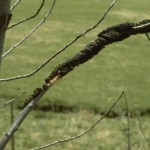Black Knot Fungus on Mayday trees and Schubert Chokecherries
Black knot (Dibotryon morbosum) is a fungal infection that is
common to the Prunus genus. This genus includes Mayday Trees and Schubert Chokecherries. Black knot disease was first described in 1821 in Pennsylvania. During the 1880’s black knot was the most destructive disease of tart cherries and plums in the United States. The disease was later spread to Canada. This disease is not as destructive as it was historically, but with several wet Calgary spring times and over irrigation the disease is making a return.
Black knot fungus causes gross cell multiplication causing abnormal swellings of the plants tissues. These growths known as galls, are found on the branches, first as green corky growths, that become hardened and black. The knots affect the trees general vigour as they stay year to year. A large infestation can eventually cause the trees demise. The galls can have a width of almost 3 inches and can grow to a length of 1 foot depending upon branch sizes.
Like most fungal diseases, spread of the spores is rapid during wet weather. Long periods of wet weather during spore production is ideal for rampant spread. Trees are generally inoculated and the rapid cell multiplication occurs previous to flowering and during active flowering. Presentation of the disease can also be during leaf drop if there is adequate moisture.
To control an infected tree, pruning is one of your best defences. There is some controversy amongst arborists about whether to prune during dormancy or active growth, but all agree that dry weather is the best time to prune. Spore production is the lowest at this time and all pruning materials should be removed, burned or sent to landfill. Prune 6 to 8 inches below the gall formation.
Prevention is your best defence against this prolific fungus. As with all fungal infections, moisture levels need to be present for survival. Watering should not be done during the evening or nighttime hours. If trees are watered in the early am, the tissues have time to dry in the heat of the day, holding back fungal growth. Drip irrigation is better for trees as it prevents overwatering of the foliage and branches. There are no recommended chemical controls.

